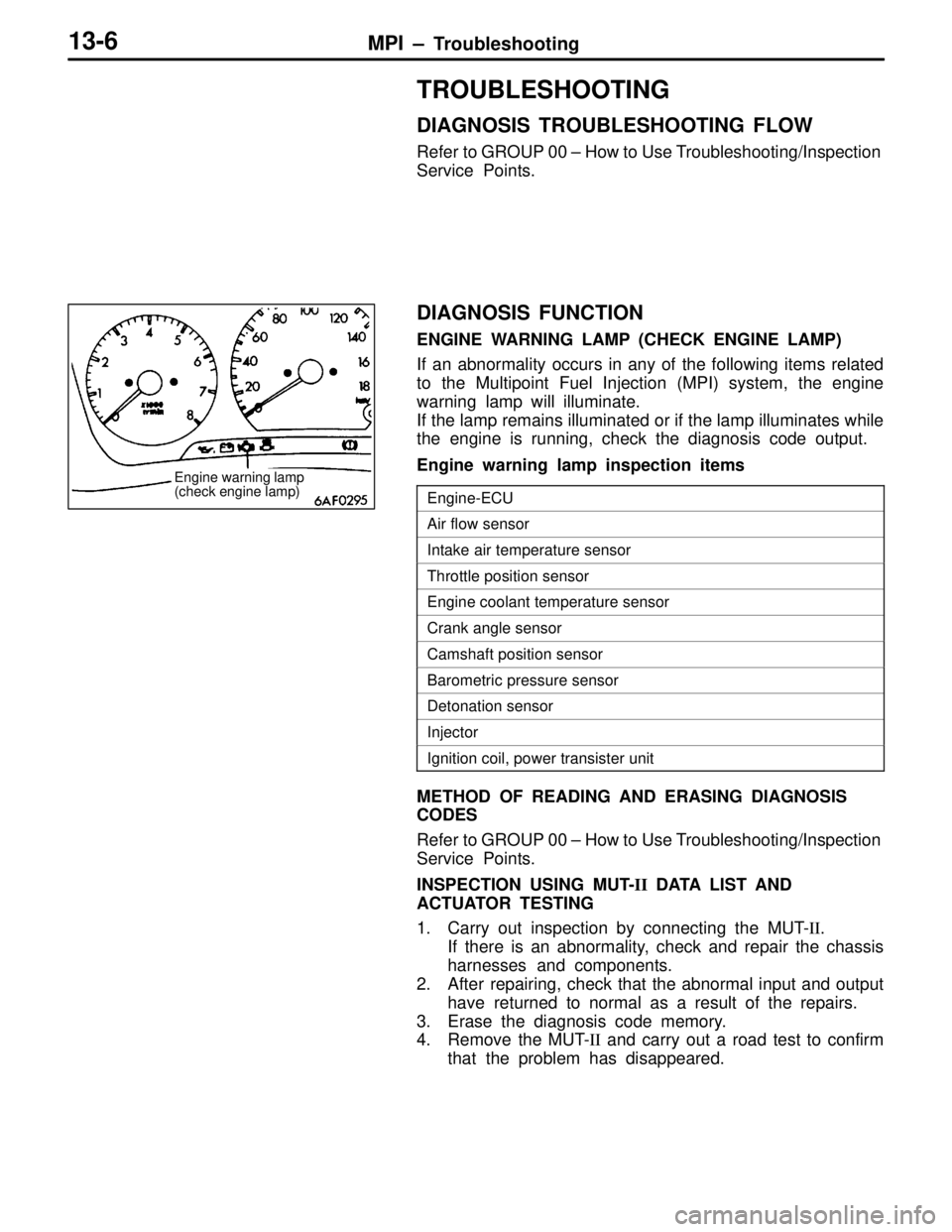Page 31 of 558
ENGINE – Specifications11-6
ItemsNm
Rocker cover3.5
Engine support bracket49
Camshaft sprocket bolt88
Timing belt rear right cover11
Timing belt rear left upper cover11
Fuel and emission control parts
Throttle body18
Fuel pressure regulator9
Delivery pipe11
Vacuum tank bracket9
Solenoid valve bracket9
Solenoid valve9
Vacuum hose and vacuum pipe11
Secondary air intake manifold
Heat protector13
Vacuum hose and vacuum pipe11
Air pipe (Heat protector side)13
Air pipe (Cam position sensor side)11
Air pipe (Eye bolt)49
Air pipe (Control valve side)24
Air control valve21
Air control valve bracket24
Intake manifold stay30
Intake manifold (M8)19
Intake manifold (M10)35
Exhaust manifold
Engine hanger12
Heat protector (Turbocharger side)14
Oxygen sensor54
Exhaust fitting bolt59
Exhaust fitting nut59
Air outlet fitting19
Page 52 of 558
ENGINE – Fuel and Emission Control Parts11-27
FUEL AND EMISSION CONTROL PARTS
REMOVAL AND INSTALLATION
1
2 3
456
78 9
1011
12
1314
15
16
9 Nm 11 N m
9 Nm 11 N m
18 Nm
Removal steps
1. Throttle body
�C�2. Throttle body gasket
3. Fuel return pipe
�B�4. Fuel pressure regulator
5. O-ring
6. Insulator
7. Insulator
�A�8. Injector9. O-ring
10. Grommet
11. Delivery pipe
12. Vacuum hose and vacuum pipe
13. Vacuum tank
14. Vacuum tank bracket
15. Solenoid valve
16. Solenoid valve bracket
Page 53 of 558
ENGINE – Fuel and Emission Control Parts11-28
INSTALLATION SERVICE POINTS
�A�INJECTORS INSTALLATION
(1) Before installing an injector, the rubber O-ring must be
lubricated with a drop of clean engine oil to aid in
installation.
(2) Install injector top end. Be careful not to damage O-ring
during installation.
�B�FUEL PRESSURE REGULATOR INSTALLATION
(1) Apply a small amount of new engine oil to the O-ring.
Insert the fuel pressure regulator into the delivery pipe
being careful not to damage the O-ring.
Caution
Be sure not to let engine oil get into the delivery
pipe.
(2) Check that the fuel pressure regulator turns smoothly.
If it does not turn smoothly, the O-ring may be trapped.
Remove the fuel pressure regulator and check the O-ring
for damage, and then re-insert it into the delivery pipe
and check once again.
�C�GASKET INSTALLATION
Position the projection as shown in the illustration.
1EN0388
Grommet
O-ring
Projection
Page 66 of 558

ENGINE – Rocker Arms and Camshaft11-41
(4) Removal the lash adjuster from the container. Then, push
down the steel ball gently and push the plunger to eliminate
diesel fuel from the pressure chamber.
Caution
Make sure the oil hole in the side of the body is pointing
toward container A. Do not point the oil hole at yourself
or other people.
(5) Place the lash adjuster in container B. Then, gently push
down the internal steel ball using wire (0.5 mm in diameter)
or special tool MD998442 and move the plunger through
5 to 10 strokes until it slides smoothly. This operation
will clean the lash adjuster’s pressure chamber.
Caution
The steel ball spring is extremely weak, so the lash
adjuster’s functionality may be lost if the air bleed
wire is pushed in hard.
(6) Remove the lash adjuster from the container. Then, push
down the steel ball gently and push the plunger to eliminate
diesel fuel from the pressure chamber.
Caution
Make sure the oil hole in the side of the body is pointing
toward container A. Do not point the oil hole at yourself
or other people.
(7) Place the lash adjuster in container C. Then, gently push
down the internal steel ball using wire (0.5 mm in diameter)
or special tool MD998442.
Caution
Do not use container C for cleaning. If cleaning is
performed in container C, foreign matter could enter
the pressure chamber when chamber is filled with
diesel fuel.
(8) Stand the lash adjuster with its plunger at the top, then
push the plunger downward firmly until it moves through
its greatest possible stroke. Return the plunger slowly,
then release the steel ball and allow the pressure chamber
to fill with diesel fuel.
MD998442
Diesel fuel
MD998442Diesel fuel
MD998442
Diesel fuel
MD998442
Diesel fuel
MD998442Diesel fuel
Page 115 of 558

MPI – General13-3
MPI System Diagram
�1 Injector
�2 ISC servo
�3 Fuel pressure control valve
�4 Waste gate solenoid valve
�5 Secondary air control solenoid valve
�Control relay
�Fuel pump relay
�A/C relay
�Ignition coil
�Exhaust temperature warning lamp
�Engine warning lamp
�Diagnosis output
�Alternator G terminal
�Fan motor relay
�Tachometer
�Fuel pump relay No.2 �1 Oxygen sensor
�2 Air flow sensor
�3 Intake air temperature sensor
�4 Throttle position sensor
�5 Idle switch
�6 Camshaft position sensor
�7 Crank angle sensor
�8 Barometric pressure sensor
�9 High temperature sensor
�10 Engine coolant temperature sensor
�11 Detonation sensor
�Power supply voltage
�Ignition switch-IG
�Ignition switch-ST
�Vehicle speed sensor
�A/C switch
�Power steering fluid pressure switch
�Alternator FR signalEngine ECU
�1 Oxygen sensor
�2 Air flow sensor�3
Intake air tem-
perature sensor
�4,
�5
�6 Camshaft position
sensor
�7 Crank angle sensor �8 Barometric
pressure sensor
�9 High temperature
sensor �10 Coolant temperature sensor
�11 Detonation sensor�1 Injector �2 ISC servo
�3 Fuel pressure
control valve
�4 Waste gate
solenoid valve �5 Secondary air
control solenoid
valveCanister
Check valveFrom
fuel
tank
Throttle position
sensor (with a
built-in
idle
switch)
Secondary
air valve
AirTo fuel
tankFuel
pressure
regulatorFrom
fuel
pump
Waste gate
actuator
Catalytic converter
Page 116 of 558
MPI – Service Specifications / Sealant13-4
SERVICE SPECIFICATIONS
ItemsSpecifications
Basic ignition timing �BTDC5 ± 3
Basic idle speed rpm850 ± 50
Throttle position sensor adjusting voltage mV400 – 1,000
Throttle position sensor resistance kΩ3.5 – 6.5
ISC servo coil resistance (at 20�C) Ω28 – 33
Intake air temperature sensor resistance kΩAt 20�C2.3 – 3.0
At 80�C0.30 – 0.42
Coolant temperature sensor resistance kΩAt 20�C2.1 – 2.7
At 80�C0.26 – 0.36
Fuel pressure kPaWhen vacuum hose is connected230
When vacuum hose is disconnected289 – 309
Injector coil resistance Ω2 – 3
Amount of injector fuel leak drop/min1 or less
Oxygen sensor output voltage V0.6 – 1.0
Fuel pressure control valve coil resistance (at 20�C) Ω28 – 36
SEALANT
ItemSpecified sealantRemark
Engine coolant temperature sensor
threaded portion3M Nut Locking Part No.4171 or equivalentDrying sealant
Page 118 of 558

MPI – Troubleshooting13-6
TROUBLESHOOTING
DIAGNOSIS TROUBLESHOOTING FLOW
Refer to GROUP 00 – How to Use Troubleshooting/Inspection
Service Points.
DIAGNOSIS FUNCTION
ENGINE WARNING LAMP (CHECK ENGINE LAMP)
If an abnormality occurs in any of the following items related
to the Multipoint Fuel Injection (MPI) system, the engine
warning lamp will illuminate.
If the lamp remains illuminated or if the lamp illuminates while
the engine is running, check the diagnosis code output.
Engine warning lamp inspection items
Engine-ECU
Air flow sensor
Intake air temperature sensor
Throttle position sensor
Engine coolant temperature sensor
Crank angle sensor
Camshaft position sensor
Barometric pressure sensor
Detonation sensor
Injector
Ignition coil, power transister unit
METHOD OF READING AND ERASING DIAGNOSIS
CODES
Refer to GROUP 00 – How to Use Troubleshooting/Inspection
Service Points.
INSPECTION USING MUT-II DATA LIST AND
ACTUATOR TESTING
1. Carry out inspection by connecting the MUT-II.
If there is an abnormality, check and repair the chassis
harnesses and components.
2. After repairing, check that the abnormal input and output
have returned to normal as a result of the repairs.
3. Erase the diagnosis code memory.
4. Remove the MUT-II and carry out a road test to confirm
that the problem has disappeared.
Engine warning lamp
(check engine lamp)
Page 119 of 558

MPI – Troubleshooting13-7
FAIL-SAFE FUNCTION REFERENCE TABLE
When the main sensor malfunctions are detected by the diagnosis function, the vehicle is controlled
by means of the pre-set control logic to maintain safe conditions for driving.
Malfunctioning itemControl contents during malfunction
Air flow sensor1. Uses the throttle position sensor signal and engine speed signal (crank angle sensor
signal) to take reading of the basic injector drive time and basic ignition timing from
the pre-set mapping.
2. Fixes the ISC servo in the appointed position so idle control is not performed.
Intake air temperature
sensorControls as if the intake air temperature is 25�C.
Throttle position
sensorNo increase in fuel injection amount during acceleration due to the throttle position sensor
signal.
Engine coolant
temperature sensor1. Controls as if the engine coolant temperature is 80�C.
(This condition is maintained until the ignition switch is turned off even when the
sensor signal returns normal.)
2. Lets the fan motor (radiator and condenser) run at high speed.
Camshaft position
sensorInjects fuel to all cylinders simultaneously for 4 seconds.
(However, after the ignition switch is turned to ON, the No. 1 cylinder top dead centre is not
detected at all.)
Barometric pressure
sensorControls as if the barometric pressure is 101 kPa.
Detonation sensorSwitches the ignition timing from ignition timing for super petrol to ignition timing for standard
petrol.
Ignition coil, power
transistor unitCuts off the fuel supply to cylinders with an abnormal ignition.
Alternator FR terminalDoes not control the output of the alternator according to an electrical load. (works as a
normal alternator)